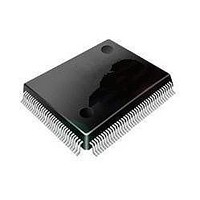STM32F417VGT6 STMicroelectronics, STM32F417VGT6 Datasheet - Page 69

STM32F417VGT6
Manufacturer Part Number
STM32F417VGT6
Description
Microcontrollers (MCU) ARM M4 1024 FLASH 168 Mhz 192kB SRAM
Manufacturer
STMicroelectronics
Datasheet
1.STM32F417IGH6.pdf
(156 pages)
Specifications of STM32F417VGT6
Core
ARM Cortex M4
Processor Series
STM32F4
Data Bus Width
32 bit
Maximum Clock Frequency
168 MHz
Program Memory Size
1024 KB
Data Ram Size
192 KB
On-chip Adc
Yes
Number Of Programmable I/os
82
Number Of Timers
10
Operating Supply Voltage
1.7 V to 3.6 V
Package / Case
LQFP-100
Mounting Style
SMD/SMT
A/d Bit Size
12 bit
A/d Channels Available
16
Interface Type
CAN, I2C, I2S, SPI, UART
Program Memory Type
Flash
Lead Free Status / Rohs Status
Details
Available stocks
Company
Part Number
Manufacturer
Quantity
Price
STM32F415xx, STM32F417xx
Table 21.
1. TBD stands for “to be defined”.
2. Based on characterization, not tested in production.
Caution:
I
Symbol
DD_VBAT
Backup
domain supply
current
Parameter
Typical and maximum current consumptions in V
I/O system current consumption
The current consumption of the I/O system has two components: static and dynamic.
I/O static current consumption
All the I/Os used as inputs with pull-up generate current consumption when the pin is
externally held low. The value of this current consumption can be simply computed by using
the pull-up/pull-down resistors values given in
For the output pins, any external pull-down or external load must also be considered to
estimate the current consumption.
Additional I/O current consumption is due to I/Os configured as inputs if an intermediate
voltage level is externally applied. This current consumption is caused by the input Schmitt
trigger circuits used to discriminate the input value. Unless this specific configuration is
required by the application, this supply current consumption can be avoided by configuring
these I/Os in analog mode. This is notably the case of ADC input pins which should be
configured as analog pins.
Any floating input pin can also settle to an intermediate voltage level or switch inadvertently,
as a result of external electromagnetic noise. To avoid current consumption related to
floating pins, they must either be configured in analog mode, or forced internally to a definite
digital value. This can be done either by using pull-up/down resistors or by configuring the
pins in output mode.
I/O dynamic current consumption
In addition to the internal peripheral current consumption measured previously (see
Table 23: Peripheral current
the current consumption. When an I/O pin switches, it uses the current from the MCU supply
voltage to supply the I/O pin circuitry and to charge/discharge the capacitive load (internal or
external) connected to the pin:
Backup SRAM ON, RTC ON
Backup SRAM OFF, low-speed
oscillator and RTC ON
Backup SRAM ON, RTC OFF
Backup SRAM OFF, RTC OFF
Conditions
consumption), the I/Os used by an application also contribute to
Doc ID 022063 Rev 1
I
SW
=
V
1.8 V
V
TBD
TBD
TBD
TBD
DD
DD
=
Table 43: I/O static
T
×
A
V
2.4 V
f
= 25 °C
TBD
TBD
TBD
TBD
Typ
SW
DD
BAT
=
×
V
C
3.3 V
mode
TBD
TBD
TBD
TBD
DD
=
(1)
T
A
Electrical characteristics
TBD
TBD
TBD
TBD
characteristics.
= 85 °C
V
(2)
(2)
(2)
(2)
DD
Max
= 3.6 V
105 °C
TBD
TBD
TBD
TBD
T
A
=
(2)
(2)
(2)
(2)
69/156
Unit
µA





















